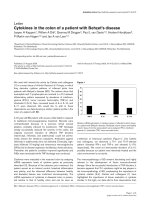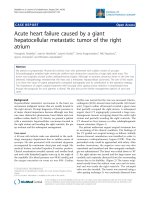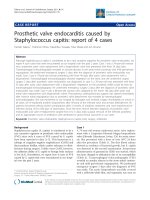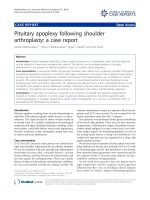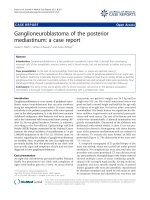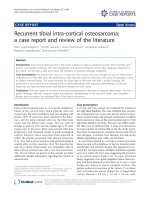Báo cáo y học: " Haemoptysis in pregnancy caused by a well-differentiated fetal adenocarcinoma: a case report" docx
Bạn đang xem bản rút gọn của tài liệu. Xem và tải ngay bản đầy đủ của tài liệu tại đây (285.22 KB, 4 trang )
CAS E REP O R T Open Access
Haemoptysis in pregnancy caused by a
well-differentiated fetal adenocarcinoma: a case
report
Rebecca J Thompson
1*
, Philip S Hasleton
2,3
, Paul M Taylor
4
, Mark Woodhead
3,5
, Louise M Byrd
1
Abstract
Introduction: Haemoptysis in pregnancy is frequently assumed to be caused by a pulmonary embolism. However,
it can also be an indicator of serious pathology.
Case presentation: We report the case of a 27-year-old Caucasian woman who presented with haemoptysis in
pregnancy that was discovered to be caused by a well-differentiated fetal adenocarcinoma of the lung.
Conclusion: This case demonstrates the importance of establishing an accurate diagnosis when a pregnant
woman presents with haemoptysis and that more serious pathology should be considered if the clinical symptoms
persist and/or the presumed diagnosis of pulmonary embolism is not confirmed.
Introduction
When the symptom of haemoptysis occurs in preg-
nancy, it is frequently assumed to be caused by a pul-
monary embolism, which is a relatively common
pathology in pregnancy. However, as in the non-preg-
nant population, it can be caused by a number of other
conditions and can be an indicator of serious pathology.
Here we present a case of haemoptysis in pregnancy
caused by a w ell-diffe rentiated fetal ade nocarcinoma of
the lung.
Case presentation
A 27-year-old Caucasian woman, gravida 2 para 1,
booked at 13 weeks gestation. An ultrasound scan con-
firmed an estimated date of delivery of April 19, 2007.
She was a fitness instructor , and had no sig nificant past
medical history, aside from a chest infection prior to
this pregnancy that was treated with antibiotics by her
General Practitioner. A smoker since the age of 17 years
(approximately ten cigarettes per d ay), she had stopped
six months previously.
The index pregnancy proceeded uneventfully until she
presented with haemoptysis to her local hospital at 25
weeks gestation. A chest x-ray suggested a possible
right-sided pneumonia. She was prescribed a course of
antibiotics, and discharged home.
When seen in the antenatal clinic at 28 weeks gesta-
tion, she reported further episodes of haemoptysis. She
was therefore admitted immediately for investigation.
The working diagnosis was pulmonary embolism and as
such she w as fully anticoagulated with low molecular
weigh t hepari n (LMWH). Arterial blood gases breathing
air were within normal limits (pO2 92.5 mmHg, 12.3
kPa; pCO2 33.6 mmHg 4.47 kPa), and sputum cultured
normal upper respiratory tract flora. A chest x-ray (Fig-
ure 1) demonstrated a small right basal pleural reaction
and some right basal atelectasis, which may indicate pul-
monary embolic disease. A perfusion lung (V/Q) scan
gave an indeterm inate risk of pulmonary embolus.
Nevertheles s, despite several days of adequate treatment
with LMWH (post dose Factor Xa 0.6), she had contin-
ued haemoptysis and a respiratory opinion was therefore
sought. As a pulmonary embolus had as yet not been
confirmed and the condition of the patient appeared to
be worsening despite adequate therapy, bilateral leg
Doppler’ s and a computed tomography pulmonary
angiogram (CTPA) were performed. The former showed
no evidence of a deep vein thrombosis. The latter
revealed no pulmonary embolus but rather a cavitating
mass of 4 cm in diameter within the right lung,
* Correspondence:
1
Department of Obstetrics and Gynaecology, St Mary’s Hospital, Hathersage
Road, Manchester M13 9WL, UK
Thompson et al. Journal of Medical Case Reports 2010, 4:17
/>JOURNAL OF MEDICAL
CASE REPORTS
© 2010 Thompson et al; licensee BioMed Central Ltd. This is an Open Access article distributed under the terms of the Cre ative
Commons Attribut ion License ( /licenses/by/2.0), which permits unrestricted use, distribution, and
reproduction in any medium, provi ded the origi nal work is properly cited.
immediately posterior to the hilum and occluding the
lower lobe bronchus (Figure 2).
LMWH was discontinued and an urgent flexible
bronchoscopy was performed 24 hours later. The view
was obscured by active bleeding, and a lthough a large
tumour was seen in the right lower lobe bronchus it
was not possible to undertake a biopsy. The woman was
therefore discharged home and readmitted within the
week for a scheduled rigid bronchoscopy. Biopsy was
performed and unfortunately histopathology indicated a
probable well-differentiated fetal adenocarcinoma.
Subsequent management was discussed in a Multidisci-
plinary Team Meet ing, involving obstetrician, respiratory
physician, cardiothoracic surgeon, radiologist and histo-
pathologist. The possibility that there may be blastamous
foci was raised. The need for appropriate staging, includ-
ing abdominal computed tomography (CT) and positron
emission tomography (PET) s can, with right pnuemo-
nectomy should the tumour be localised, was agreed. As
the safe use of PET in pregnancy has yet to be evaluated,
it was decided that the baby should be delivered first.
Given that the woman was then 31+ 4 weeks gestation
it was decided that she should receive corticosteroids
over the following 48 hours (betamethasone 12 mg IM
24 hours apart), so as to encourage fetal lung matura-
tion, with a view to delivery during 32 weeks of gesta-
tion. As there were some concerns as to whether
Valsalva during second stage (that is active pushing)
might precipitate significant haemoptysis from an appar-
ently vascular tumour, an electi ve caesarean sectio n was
considered. However, following discussions with the
woman, who was very keen to avoid such surgery, it was
agreed that an induction should be attempted. Fortu-
nately, following two does of prostaglandin, an amniot-
omy was possible. After that, she went on to deliver a
male infant weighing 1970 gm.
Four days following delivery, a PET scan suggested
that the tum our within the right bronchu s was confined
to the right lower and middle lobes of the lung.
Within ten days of delivery she was admitted for right
lower and middle lobectomy. Several large sub-carinal
glands were also removed. Surgery went w ell without
Figure 1 Chest X-ray showing a small right basal pleural reaction and some right basal atelectasis.
Thompson et al. Journal of Medical Case Reports 2010, 4:17
/>Page 2 of 4
event and the patient recovered ra pidly and was dis-
charged within a week.
Subsequent histology confirmed a well-differentiated
fetal adenocarcinoma of the lung with one microscopic
focus of blastoma, which appeared after sectioning the
entire tumour. The mediastinal glands were not involved
but tumour was present at the bronchial resection mar-
gin. As this tumour is not usually radiosensitive, it was
decided that the remaining right upper lobe should be
remov ed in order to affect a possible cure with the least
possible chance of recurrence.
Again surgery wa s uneventful, and she made a quick
recovery. However, histology from the completion pne-
monectomy suggested the possibility of microscopic
residual disease around the area of the stump of the
right main bronchus. The clinical oncologists suggested
treatment with radical external beam radiotherapy to try
to prevent disease recurrence around the bronchial
stump, which she underwent with minimal side effects.
A year following diagnosis, the patient is well and
recurrence free. She does, however, report a persistent
dry cough and breathlessness on severe exertion.
Discussion
Well-differentiated fetal adenocarcinoma (WDFA) is
classified by the World Health Organisation as a variant
of adenocarcinoma. When fetal adenocarcinoma is asso-
ciated with primitive blastemal stroma, it is classified as
a pulmonary blastoma. In this case, there was only a
microscopic focus of blastomatous tissue, so we were
not totally certain that the categorisation into blastoma
was correct. Pulmonary blastoma is a rare malignant
tumour comprising 0.25 - 0.5% of all primary lung
tumours [1-3]. Histo logical ly, the WDFA element char-
acteristically demonstrates neoplastic glands that resem-
ble fetal lung and squamoid morules with clear nuclei
[1]. The immature mesenchyme and epithelium mimic
the embryonic lung at 10-16 weeks gestation [2]. The
name WDFA is therefore derived from the histological
appearances of the tumour. There is currently no
known relationship between pulmonary blastoma and
pregnancy. One study has hypothesised that oestrogen
may be inv olved in the development of pulmonary blas-
toma through the oestrogen receptor-b [4], but in this
case, the tumour was negative for this oestrogen
receptor.
The peak incidence of pulmonary blastoma is 35-40
years of age, with an equal sex distribution. 80% of
patients are smokers [3]. Our patient was somewhat
younger, at only 27 years of age. Although she is cur-
rently a non-smoker, she had smoked for ten years prior
to diagnosis. Patients may be asymptomatic or present
with persistent cough, haemoptysis (as in this case) or
chest pain.
The standard treatment for pulmonary blastoma is
surgical resection [2,3], although there have been reports
of limited success with adjuvant r adiotherapy and che-
motherapy [2]. The prognosis of pulmonary blastomas is
poor, although compared with its biphasic counterpart,
that of WDFA is better [5] (particularly when resection
is complete), with a mortality rate of 14% and 52%
respectively [3].
To the best of ou r knowledge this is the first reported
case of WDFA diagnosed in pregnancy, although there
has been a case of WDFA identified in a woman three
months post partum [3], and one of a biphasic pulmon-
ary blastoma diagnosed in pregnancy [6]. However,
other types of lung carcinomas have been described in
pregnancy. In most cases, the disease is reported as
highly aggressive and frequently fatal.
Conclusion
This case of well-differentiated fetal adenocarcinoma in
pregnancy demonstrates the importance of establishing
an accurate diagnosis when a pregnant woman presents
with haemoptysis, cough and/or chest pain. When the
clinical symptoms are persistent and/or a V/Q scan pro-
vides no logical explanation, it is important to seek
advice from a sen ior respiratory physician, and consi der
undertaking a CTPA, both of which can play a vital role
in identifying rare but life threatening lung pathology.
Consent
Written informed consent was obtained from the patient
for publication o f this case report and accompanying
images. A copy of the written consent is available for
review by the journal’s Editor-in-Chief.
Abbreviations
CTPA: computed tomography pulmonary angiogram; LMWH: low molecular
weight heparin; PET: positron emission tomography; WDFA: well-
differentiated fetal adenocarcinoma.
Acknowledgements
We would like to thank the patient for giving her permission for her case to
be presented.
Author details
1
Department of Obstetrics and Gynaecology, St Mary’s Hospital, Hathersage
Road, Manchester M13 9WL, UK.
2
Department of Histopathology, The
University of Manchester, Oxford Road, Manchester M13 9PT, UK.
3
School of
Medicine, The University of Manchester, Oxford Road, Manchester M13 9PT,
UK.
4
Department of Radiology, Manchester Royal Infirmary, Oxford Road,
Manchester M13 9WL, UK.
5
Department of Respiratory Medicine, Manchester
Royal Infirmary, Oxford Road, Manchester M13 9WL, UK.
Authors’ contributions
LMB, PSH, PMT and MW were involved in the multidisciplinary management
of this case. RJT wrote the manuscript with the help and guidance of LMB.
All authors reviewed the manuscript and contributed to the discussion.
Competing interests
The authors declare that they have no competing interests.
Thompson et al. Journal of Medical Case Reports 2010, 4:17
/>Page 3 of 4
Received: 5 November 2009
Accepted: 20 January 2010 Published: 20 January 2010
References
1. Adluri RK, Boddu SR, Martin-Ucar A, Duffy JP, Beggs FD, Morgan WE:
Pulmonary blastoma - a rare tumor with variable presentation. Eur J
Cardiothorac Surg 2006, 29:236-239.
2. Cutler CS, Michel RP, Yassa M, Langleben A: Pulmonary blastoma: case
report of a patient with a 7-year remission and review of chemotherapy
experience in the world literature. Cancer 1998, 82:462-467.
3. Esper A, Force S, Gal A, Wolfenden LL: A 36-year-old woman with
hemoptysis and a lung mass 3 months after delivery. Chest 2006,
130:1620-1623.
4. Nakatani Y, Masudo K, Nozawa A, Inayama Y, Yamanaka S, Ito T, Kitamura H,
Notohara K, Kashima K, Yokoyama S, Tsujimoto M, Tamai S, Abe Y, Resl M,
Mark EJ: Biotin-rich, optically clear nuclei express estrogen receptor-beta:
tumors with morules may develop under the influence of estrogen and
aberrant beta-catenin expression. Hum Pathol 2004, 35:869-874.
5. Koss MN, Hochholzer L, O’Leary T: Pulmonary blastomas. Cancer 1991,
67(9):2368-2381.
6. Zaidi A, Zamvar V, Macbeth F, Gibbs AR, Kulatilake N, Butchart EG:
Pulmonary blastoma: medium-term results from a regional centre. Ann
Thorac Surg 2002, 73:1572-1575.
doi:10.1186/1752-1947-4-17
Cite this article as: Thompson et al.: Haemoptysis in pregnancy caused
by a
well-differentiated fetal adenocarcinoma: a case report. Journal of
Medical Case Reports 2010 4:17.
Publish with Bio Med Central and every
scientist can read your work free of charge
"BioMed Central will be the most significant development for
disseminating the results of biomedical research in our lifetime."
Sir Paul Nurse, Cancer Research UK
Your research papers will be:
available free of charge to the entire biomedical community
peer reviewed and published immediately upon acceptance
cited in PubMed and archived on PubMed Central
yours — you keep the copyright
Submit your manuscript here:
/>BioMedcentral
Thompson et al. Journal of Medical Case Reports 2010, 4:17
/>Page 4 of 4
